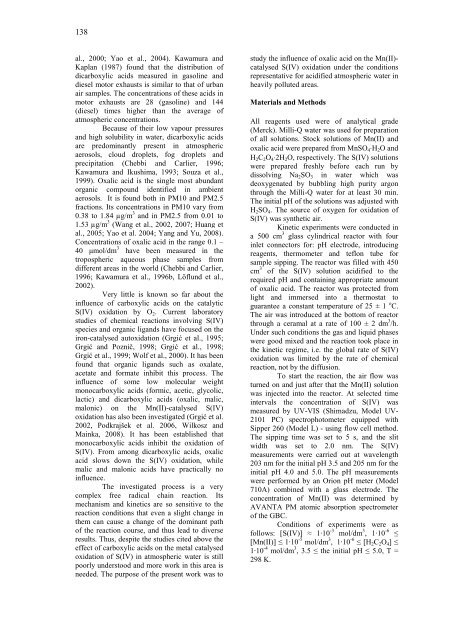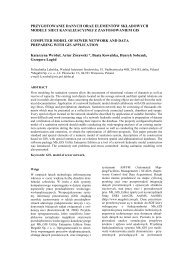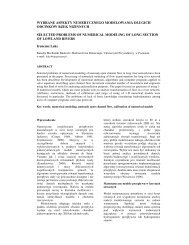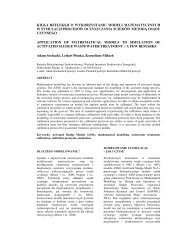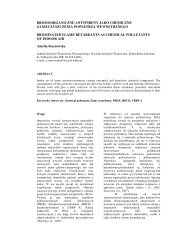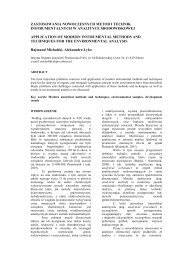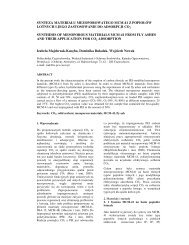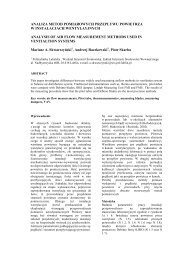influence of oxalic acid on the catalytic s
influence of oxalic acid on the catalytic s
influence of oxalic acid on the catalytic s
You also want an ePaper? Increase the reach of your titles
YUMPU automatically turns print PDFs into web optimized ePapers that Google loves.
138<br />
al., 2000; Yao et al., 2004). Kawamura and<br />
Kaplan (1987) found that <strong>the</strong> distributi<strong>on</strong> <str<strong>on</strong>g>of</str<strong>on</strong>g><br />
dicarboxylic <str<strong>on</strong>g>acid</str<strong>on</strong>g>s measured in gasoline and<br />
diesel motor exhausts is similar to that <str<strong>on</strong>g>of</str<strong>on</strong>g> urban<br />
air samples. The c<strong>on</strong>centrati<strong>on</strong>s <str<strong>on</strong>g>of</str<strong>on</strong>g> <strong>the</strong>se <str<strong>on</strong>g>acid</str<strong>on</strong>g>s in<br />
motor exhausts are 28 (gasoline) and 144<br />
(diesel) times higher than <strong>the</strong> average <str<strong>on</strong>g>of</str<strong>on</strong>g><br />
atmospheric c<strong>on</strong>centrati<strong>on</strong>s.<br />
Because <str<strong>on</strong>g>of</str<strong>on</strong>g> <strong>the</strong>ir low vapour pressures<br />
and high solubility in water, dicarboxylic <str<strong>on</strong>g>acid</str<strong>on</strong>g>s<br />
are predominantly present in atmospheric<br />
aerosols, cloud droplets, fog droplets and<br />
precipitati<strong>on</strong> (Chebbi and Carlier, 1996;<br />
Kawamura and Ikushima, 1993; Souza et al.,<br />
1999). Oxalic <str<strong>on</strong>g>acid</str<strong>on</strong>g> is <strong>the</strong> single most abundant<br />
organic compound identified in ambient<br />
aerosols. It is found both in PM10 and PM2.5<br />
fracti<strong>on</strong>s. Its c<strong>on</strong>centrati<strong>on</strong>s in PM10 vary from<br />
0.38 to 1.84 µg/m 3 and in PM2.5 from 0.01 to<br />
1.53 µg/m 3 (Wang et al., 2002, 2007; Huang et<br />
al., 2005; Yao et al. 2004; Yang and Yu, 2008).<br />
C<strong>on</strong>centrati<strong>on</strong>s <str<strong>on</strong>g>of</str<strong>on</strong>g> <str<strong>on</strong>g>oxalic</str<strong>on</strong>g> <str<strong>on</strong>g>acid</str<strong>on</strong>g> in <strong>the</strong> range 0.1 –<br />
40 µmol/dm 3 have been measured in <strong>the</strong><br />
tropospheric aqueous phase samples from<br />
different areas in <strong>the</strong> world (Chebbi and Carlier,<br />
1996; Kawamura et al., 1996b, Löflund et al.,<br />
2002).<br />
Very little is known so far about <strong>the</strong><br />
<str<strong>on</strong>g>influence</str<strong>on</strong>g> <str<strong>on</strong>g>of</str<strong>on</strong>g> carboxylic <str<strong>on</strong>g>acid</str<strong>on</strong>g>s <strong>on</strong> <strong>the</strong> <strong>catalytic</strong><br />
S(IV) oxidati<strong>on</strong> by O2. Current laboratory<br />
studies <str<strong>on</strong>g>of</str<strong>on</strong>g> chemical reacti<strong>on</strong>s involving S(IV)<br />
species and organic ligands have focused <strong>on</strong> <strong>the</strong><br />
ir<strong>on</strong>-catalysed autoxidati<strong>on</strong> (Grgić et al., 1995;<br />
Grgić and Poznič, 1998; Grgić et al., 1998;<br />
Grgić et al., 1999; Wolf et al., 2000). It has been<br />
found that organic ligands such as oxalate,<br />
acetate and formate inhibit this process. The<br />
<str<strong>on</strong>g>influence</str<strong>on</strong>g> <str<strong>on</strong>g>of</str<strong>on</strong>g> some low molecular weight<br />
m<strong>on</strong>ocarboxylic <str<strong>on</strong>g>acid</str<strong>on</strong>g>s (formic, acetic, glycolic,<br />
lactic) and dicarboxylic <str<strong>on</strong>g>acid</str<strong>on</strong>g>s (<str<strong>on</strong>g>oxalic</str<strong>on</strong>g>, malic,<br />
mal<strong>on</strong>ic) <strong>on</strong> <strong>the</strong> Mn(II)-catalysed S(IV)<br />
oxidati<strong>on</strong> has also been investigated (Grgić et al.<br />
2002, Podkrajšek et al. 2006, Wilkosz and<br />
Mainka, 2008). It has been established that<br />
m<strong>on</strong>ocarboxylic <str<strong>on</strong>g>acid</str<strong>on</strong>g>s inhibit <strong>the</strong> oxidati<strong>on</strong> <str<strong>on</strong>g>of</str<strong>on</strong>g><br />
S(IV). From am<strong>on</strong>g dicarboxylic <str<strong>on</strong>g>acid</str<strong>on</strong>g>s, <str<strong>on</strong>g>oxalic</str<strong>on</strong>g><br />
<str<strong>on</strong>g>acid</str<strong>on</strong>g> slows down <strong>the</strong> S(IV) oxidati<strong>on</strong>, while<br />
malic and mal<strong>on</strong>ic <str<strong>on</strong>g>acid</str<strong>on</strong>g>s have practically no<br />
<str<strong>on</strong>g>influence</str<strong>on</strong>g>.<br />
The investigated process is a very<br />
complex free radical chain reacti<strong>on</strong>. Its<br />
mechanism and kinetics are so sensitive to <strong>the</strong><br />
reacti<strong>on</strong> c<strong>on</strong>diti<strong>on</strong>s that even a slight change in<br />
<strong>the</strong>m can cause a change <str<strong>on</strong>g>of</str<strong>on</strong>g> <strong>the</strong> dominant path<br />
<str<strong>on</strong>g>of</str<strong>on</strong>g> <strong>the</strong> reacti<strong>on</strong> course, and thus lead to diverse<br />
results. Thus, despite <strong>the</strong> studies cited above <strong>the</strong><br />
effect <str<strong>on</strong>g>of</str<strong>on</strong>g> carboxylic <str<strong>on</strong>g>acid</str<strong>on</strong>g>s <strong>on</strong> <strong>the</strong> metal catalysed<br />
oxidati<strong>on</strong> <str<strong>on</strong>g>of</str<strong>on</strong>g> S(IV) in atmospheric water is still<br />
poorly understood and more work in this area is<br />
needed. The purpose <str<strong>on</strong>g>of</str<strong>on</strong>g> <strong>the</strong> present work was to<br />
study <strong>the</strong> <str<strong>on</strong>g>influence</str<strong>on</strong>g> <str<strong>on</strong>g>of</str<strong>on</strong>g> <str<strong>on</strong>g>oxalic</str<strong>on</strong>g> <str<strong>on</strong>g>acid</str<strong>on</strong>g> <strong>on</strong> <strong>the</strong> Mn(II)catalysed<br />
S(IV) oxidati<strong>on</strong> under <strong>the</strong> c<strong>on</strong>diti<strong>on</strong>s<br />
representative for <str<strong>on</strong>g>acid</str<strong>on</strong>g>ified atmospheric water in<br />
heavily polluted areas.<br />
Materials and Methods<br />
All reagents used were <str<strong>on</strong>g>of</str<strong>on</strong>g> analytical grade<br />
(Merck). Milli-Q water was used for preparati<strong>on</strong><br />
<str<strong>on</strong>g>of</str<strong>on</strong>g> all soluti<strong>on</strong>s. Stock soluti<strong>on</strong>s <str<strong>on</strong>g>of</str<strong>on</strong>g> Mn(II) and<br />
<str<strong>on</strong>g>oxalic</str<strong>on</strong>g> <str<strong>on</strong>g>acid</str<strong>on</strong>g> were prepared from MnSO4⋅H2O and<br />
H2C2O4⋅2H2O, respectively. The S(IV) soluti<strong>on</strong>s<br />
were prepared freshly before each run by<br />
dissolving Na2SO3 in water which was<br />
deoxygenated by bubbling high purity arg<strong>on</strong><br />
through <strong>the</strong> Milli-Q water for at least 30 min.<br />
The initial pH <str<strong>on</strong>g>of</str<strong>on</strong>g> <strong>the</strong> soluti<strong>on</strong>s was adjusted with<br />
H2SO4. The source <str<strong>on</strong>g>of</str<strong>on</strong>g> oxygen for oxidati<strong>on</strong> <str<strong>on</strong>g>of</str<strong>on</strong>g><br />
S(IV) was syn<strong>the</strong>tic air.<br />
Kinetic experiments were c<strong>on</strong>ducted in<br />
a 500 cm 3 glass cylindrical reactor with four<br />
inlet c<strong>on</strong>nectors for: pH electrode, introducing<br />
reagents, <strong>the</strong>rmometer and tefl<strong>on</strong> tube for<br />
sample sipping. The reactor was filled with 450<br />
cm 3 <str<strong>on</strong>g>of</str<strong>on</strong>g> <strong>the</strong> S(IV) soluti<strong>on</strong> <str<strong>on</strong>g>acid</str<strong>on</strong>g>ified to <strong>the</strong><br />
required pH and c<strong>on</strong>taining appropriate amount<br />
<str<strong>on</strong>g>of</str<strong>on</strong>g> <str<strong>on</strong>g>oxalic</str<strong>on</strong>g> <str<strong>on</strong>g>acid</str<strong>on</strong>g>. The reactor was protected from<br />
light and immersed into a <strong>the</strong>rmostat to<br />
guarantee a c<strong>on</strong>stant temperature <str<strong>on</strong>g>of</str<strong>on</strong>g> 25 ± 1 o C.<br />
The air was introduced at <strong>the</strong> bottom <str<strong>on</strong>g>of</str<strong>on</strong>g> reactor<br />
through a ceramal at a rate <str<strong>on</strong>g>of</str<strong>on</strong>g> 100 ± 2 dm 3 /h.<br />
Under such c<strong>on</strong>diti<strong>on</strong>s <strong>the</strong> gas and liquid phases<br />
were good mixed and <strong>the</strong> reacti<strong>on</strong> took place in<br />
<strong>the</strong> kinetic regime, i.e. <strong>the</strong> global rate <str<strong>on</strong>g>of</str<strong>on</strong>g> S(IV)<br />
oxidati<strong>on</strong> was limited by <strong>the</strong> rate <str<strong>on</strong>g>of</str<strong>on</strong>g> chemical<br />
reacti<strong>on</strong>, not by <strong>the</strong> diffusi<strong>on</strong>.<br />
To start <strong>the</strong> reacti<strong>on</strong>, <strong>the</strong> air flow was<br />
turned <strong>on</strong> and just after that <strong>the</strong> Mn(II) soluti<strong>on</strong><br />
was injected into <strong>the</strong> reactor. At selected time<br />
intervals <strong>the</strong> c<strong>on</strong>centrati<strong>on</strong> <str<strong>on</strong>g>of</str<strong>on</strong>g> S(IV) was<br />
measured by UV-VIS (Shimadzu, Model UV-<br />
2101 PC) spectrophotometer equipped with<br />
Sipper 260 (Model L) - using flow cell method.<br />
The sipping time was set to 5 s, and <strong>the</strong> slit<br />
width was set to 2.0 nm. The S(IV)<br />
measurements were carried out at wavelength<br />
203 nm for <strong>the</strong> initial pH 3.5 and 205 nm for <strong>the</strong><br />
initial pH 4.0 and 5.0. The pH measurements<br />
were performed by an Ori<strong>on</strong> pH meter (Model<br />
710A) combined with a glass electrode. The<br />
c<strong>on</strong>centrati<strong>on</strong> <str<strong>on</strong>g>of</str<strong>on</strong>g> Mn(II) was determined by<br />
AVANTA PM atomic absorpti<strong>on</strong> spectrometer<br />
<str<strong>on</strong>g>of</str<strong>on</strong>g> <strong>the</strong> GBC.<br />
C<strong>on</strong>diti<strong>on</strong>s <str<strong>on</strong>g>of</str<strong>on</strong>g> experiments were as<br />
follows: [S(IV)] ≈ 1·10 -3 mol/dm 3 , 1·10 -6 ≤<br />
[Mn(II)] ≤ 1·10 -5 mol/dm 3 , 1·10 -6 ≤ [H2C2O4] ≤<br />
1·10 -4 mol/dm 3 , 3.5 ≤ <strong>the</strong> initial pH ≤ 5.0, T =<br />
298 K.


